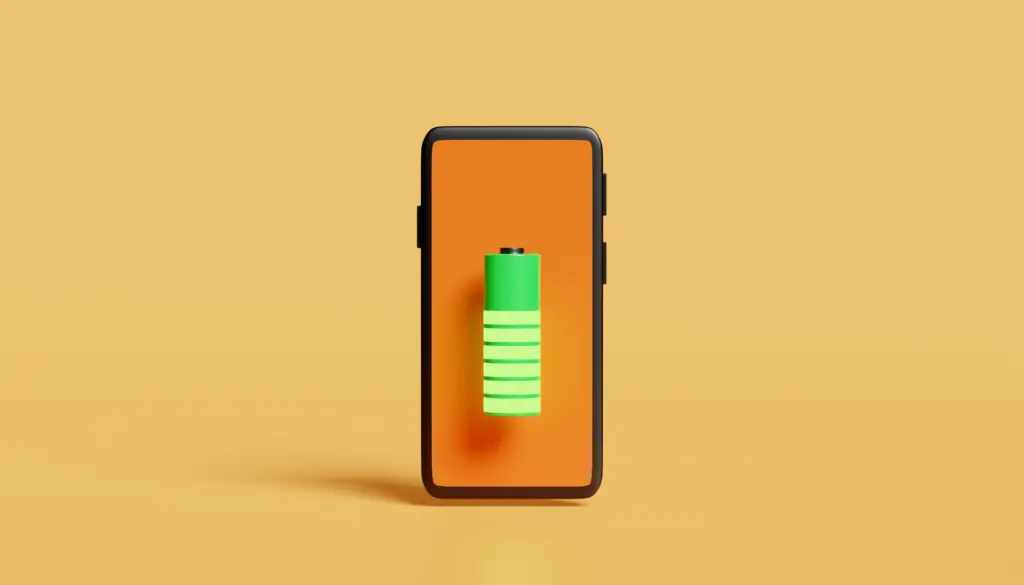Have you ever paused and stared in amazement as your phone battery raced from zero to a hundred in record time? While it might seem like you’ve unlocked a hidden feature, or a “turbocharging mode” for your device, the reality could be more akin to a warning light on your car’s dashboard. It’s likely you haven’t unlocked a new type of fast charging mode and more likely that your phone’s battery is having issues.
In this article, we’ll jump deep into this issue and discover why that lightning-fast battery replenishment could be a symptom of a deeper issue.
Table of Contents
Why is My Phone Charging So Fast?

When a phone charges unusually fast, it may indicate a degraded battery, where reduced capacity can give an illusion of quicker charging. Other factors include faulty battery cells, using more powerful charging bricks, issues with the charging circuit, software malfunctions, or the use of non-standard third-party chargers. It’s good to be able to tell the difference between fast charging by design and potential battery or circuit issues, as the latter may reduce battery lifespan or pose safety risks.
Let’s get into a bit more detail on the common reasons your phone can start charging too fast.
Degraded Battery Capacity
A degraded battery has experienced a reduction in its overall capacity over time. This capacity loss means there’s less ‘space’ for the battery to fill when charging and this leads to an illusion of faster charging.
To add to the issue, as the battery’s capacity diminishes, reaching its maximum charge (which might display as 100% on your phone) doesn’t actually equate to the full original capacity of a new battery. It’s more like reaching the maximum of its now reduced capacity.
What Can You Do About It?
To address this, most modern smartphones have built-in tools to check battery health and provide insights into the battery’s state.
If your battery has severely deteriorated it probably won’t hold charge past evening and a battery replacement will be the way to go. If the battery is non-removable or you just don’t fancy buying a new one yet, regularly plugging into a power bank might help you out until you can make it to a repair shop or buy a new battery.
You’ve Switched to Using a More Powerful Charging Brick or Cable
One factor that might contribute to your phone charging faster is the power output of your charging brick. Charging bricks, also known as wall chargers or power adapters, come with varying power outputs, measured in watts (W).
If you’ve recently switched to a charger with a higher wattage, your phone might be charging faster because it’s receiving more power per unit of time. This is similar to pouring water into a glass – the bigger the pitcher, the faster the glass fills up.
Just make sure your phone is compatible with higher power inputs. Most modern smartphones can handle fast charging, but older models might not be up for it. Charging a device with a power adapter that provides more power than the device can handle can lead to battery degradation and overheating.
Always refer to your phone’s manual or the manufacturer’s guidelines to determine the safe power input range for your device. If in doubt, stick to the charger that came with your phone or one that’s certified by your phone’s manufacturer.
Likewise, if you switch to a better quality cable, the additional speed at which your phone charges at can be really noticeable.
Faulty Battery Cells
Battery cells are the core components that store and release energy in your smartphone. A typical lithium-ion battery contains multiple cells that work together to provide power to your device. When one or more of these cells become faulty, the overall capacity of the battery can be reduced. Just as with a degraded battery, a battery with faulty cells has less ‘space’ to fill, which can lead to an appearance of faster charging.
Faulty cells can also disrupt the normal charging process. This disruption might make the phone’s software think the battery is charged more than it actually is, leading to premature charging completion notifications.
Faulty cells can arise from manufacturing defects, excessive heat, physical damage, or simply as a result of natural wear and tear over time. Not only can they result in abnormal charging behavior, but they can also pose risks such as overheating, swelling, or in rare cases, catching fire.
What Can You Do About It?
If you suspect your phone’s battery contains faulty cells, you really should try to sort out the issue promptly to prevent potential harm or further damage to your phone.
Start by monitoring your phone’s behavior during charging. If it gets excessively hot or the battery drains very quickly after a full charge, these can be signs of faulty cells. You should also avoid using fast chargers, as they can exacerbate the problem.
Because this could potentially be a health hazard, it’s advisable to visit an authorized service center to get a professional diagnosis. If the battery is indeed found to have faulty cells, replacing the battery is often the best solution. Using your phone with a compromised battery isn’t just bad for device performance; it’s also a safety risk.
Check that any replacement battery is genuine and from a trusted source. Non-genuine batteries can come with their own set of problems and might not meet the safety standards of the original.
Issues with the Charging Circuit
The charging circuit, often referred to as the power management IC (integrated circuit), plays a pivotal role in controlling how power is delivered and managed within your smartphone. It ensures that the right amount of power is fed to the battery, manages the distribution of power to the phone’s components, and ensures the battery doesn’t overcharge.
When there are issues with the charging circuit, a slew of charging anomalies can occur. One of these anomalies can be rapid charging. Here’s how:
- Miscommunication: A faulty charging circuit might misread or miscommunicate the actual state of the battery, causing it to pump more power than needed. This could lead to the battery appearing to charge faster than usual.
- Regulation Issues: The circuit’s role is to regulate the power flow. If it fails to do so properly, it might allow for a higher current to flow into the battery, making it charge rapidly.
- False Reporting: Sometimes, the issue isn’t with the charging speed itself, but with how the charging process is reported by the software. The circuit could send incorrect information to the software, leading your phone to display a higher battery percentage than what’s actually stored.
What Can You Do About It?
Diagnostics: Many phone repair shops have diagnostic tools that can pinpoint issues with the charging circuit. If you suspect a problem, it’s worth having a professional look.
Avoid Third-Party Chargers: Not all chargers are made equal. Some might not communicate well with your phone’s charging circuit, leading to potential issues. Stick to certified and recommended chargers for your device.
Software Updates: Occasionally, what seems like a hardware issue might be software-related. Ensure your phone is running the latest software, as manufacturers often release patches for known bugs.
Replacement: If the charging circuit is indeed faulty and causing rapid charging, you may need to replace the motherboard of the phone, as the power management IC is typically integrated into it. This can be an expensive fix, so weigh the cost against the value and age of your phone.
Software Bugs or Malfunctions
The software in your smartphone is a complex mesh of code designed to optimize the performance and functionality of your hardware, including battery management. However, sometimes, bugs or glitches in this software can impact how your phone charges. Here’s a bit of a deeper look:
Misreading Battery Levels: Software bugs can lead to the system misinterpreting the battery’s actual state, making it seem like it’s charging faster. For instance, the software might inaccurately read a 50% charge as 80%.
Inefficient Power Management: A software glitch could affect how power is managed and distributed, resulting in irregular charging speeds.
Corrupt Calibration Data: Over time, the data that helps the phone understand the battery’s state of charge can become corrupt. This can make the phone think the battery is empty when it’s half-full, or vice versa, affecting the perceived charging speed.
What Can You Do About It?
- Update Your Software: Always ensure your device’s operating system and apps are up-to-date. Manufacturers often release updates that fix known bugs or improve system stability.
- Reset Battery Calibration: If you suspect that the battery’s calibration data might be off, you can try recalibrating the battery. This often involves draining the battery completely and then charging it to 100% without interruption.
- Factory Reset: If the issue persists and you suspect it’s software-related, performing a factory reset might help. This will return your phone to its original settings and can clear out potential software issues. Remember to back up your data before doing this.
- Seek Expert Help: If software solutions don’t rectify the problem, consult with professionals or authorized service centers. They may have insights into specific software issues or can guide you on potential hardware problems that mimic software bugs.
- Stay Informed: Join online forums or communities related to your phone brand or model. Users often share their experiences with software issues, and you might find solutions or workarounds that others have successfully employed.
Related Article: 32 Reasons Your Phone is Not Charging (And How to Fix Them)
Third-Party Chargers and Cables
Every smartphone manufacturer recommends using original or certified charging accessories, and there’s a good reason behind it. Third-party chargers and cables, especially ones that are not certified, can be outright bad and vary significantly in quality and specifications.
- Mismatched Power Specs: Third-party chargers might deliver power at a rate that doesn’t match your phone’s specifications. This mismatch can cause the phone to charge faster than it should, potentially stressing the battery.
- Poor Quality Components: Low-quality cables might not have the necessary resistance or might be constructed poorly, leading to faster power transfer, which can be harmful in the long run.
- Absence of Essential Features: Premium chargers often come with smart features that adjust the power flow based on the battery’s needs. Many third-party chargers lack these, leading to a constant flow of high power.
What Can You Do About It?
- Use Certified Accessories: Always opt for chargers and cables that are certified by your phone’s manufacturer or have a reputable third-party certification. These undergo rigorous testing to ensure they meet standard safety and efficiency criteria.
- Monitor Charging Behavior: If you’re using a new charger or cable, observe how your phone behaves. Excessive heat or unusual charging speeds can be red flags.
- Educate Yourself: Familiarize yourself with your phone’s charging specifications, so you know what to look for when purchasing third-party accessories. This knowledge helps in making informed decisions.
Your iPhone Charging and Dying Too Fast
When your iPhone charges too quickly and also drains rapidly, you’ll need to discern whether this behaviour is due to a battery issue or something else. Here’s how you can investigate:
Check for Battery Failure:
Start by ruling out a battery failure. You can use a free app like Battery Life to check your battery’s internal state of wear. Alternatively, visit an Apple store or contact Apple support to have your battery tested. If your phone is still under warranty, this could be a quick, cost-effective solution. Apple’s Support website lets you check your service and support coverage.
If your battery is found to be defective, Apple will replace it for free if it’s within warranty. Out-of-warranty replacements run at around $80. However, battery failures in even relatively new iPhones are quite rare.
Try to Recalibrate the Battery Gauge:
If your battery passes the tests, the next step is to recalibrate your battery gauge. This process helps your device accurately display the battery level. Here’s how to do it:
- Charge your iPhone to 100% using an Apple USB wall adapter.
- Use your iPhone until the battery runs down and the phone shuts off.
- If your phone shuts off with more than 1% battery left, charge it for only a minute, then continue using it until the battery drains further. Repeat this process until your phone only shuts off at 1%.
- Once your phone shuts off at 1%, charge it back to 100% without interruption.
If your battery is healthy, this recalibration process should rectify the issue of your iPhone charging and dying too fast. It helps the device accurately assess and display the battery levels.
The Implications of Your Phone Charging So Fast
A phone charging up like it’s been connected to a lightning bolt might initially seem like a blessing, but you’ll need to understand if this fast charging could be hazardous. Let’s look a little closer at the potential issues.
Reduced Battery Lifespan
Consistent rapid charging that’s not by design can stress the battery and cause it to degrade even faster. This means you might find yourself needing to charge your phone more frequently over time or even replace the battery sooner than expected.
Overheating Risks
Excessive charging speeds can generate a lot of heat. Not only can this damage the internal components of your phone, but consistent overheating can pose a major risk. It can compromise the structural integrity of the battery, leading to potential swelling or, in extreme cases, combustion.
Unreliable Battery Percentage
A phone that charges up too quickly may also misrepresent its actual battery percentage. This can lead to unexpected shutdowns or the need to charge more frequently, as the displayed 100% battery level displayed on your phone mightn’t be a true figure and could drain way faster than anticipated.
Compromised Performance
Just as your body can’t function optimally under excessive heat and stress, your phone’s performance might take a hit due to the stress rapid charging places on its battery and circuits. This can manifest as slower app launches, your phone freezing regularly, a general lag in responsiveness, or even unexpected restarts.
Safety Concerns
In the worst scenarios, a rapidly charging phone can become a safety hazard. Batteries that are being charged in an unintended and possibly unsafe way are at risk of catching fire or exploding, especially if there are underlying issues like faulty cells or compromised circuits.
Have you ever seen a video of a phone turning into a firework in someone’s hand or pocket? It’s a scary thing to witness.
The Difference Between Deliberate Fast-Charging and Problematic Fast Charging
In our fast-paced lifestyles, the demand for quicker charging solutions has led to the advent of “fast-charging” technologies. But there’s a fine line between the controlled speed of deliberate fast charging and the unintended rapidity of problematic fast charging. Let’s look more at these differences:
Controlled vs. Uncontrolled
Deliberate fast charging is a result of sophisticated technology and design. It’s an intentional feature developed by manufacturers, ensuring power is delivered to the battery in a controlled manner to achieve quicker charging without harming the device.
Fast charging operates on the same basic idea as regular charging. However, it sends a much stronger electric current (measured in Amperes) through the cable compared to a standard charger.
Problematic fast charging, on the other hand, is an uncontrolled process, often due to defects or malfunctions, which can be harmful to the battery’s health and the device’s longevity.
Safety Protocols
Modern fast-charging methods have built-in safety protocols. These protocols monitor battery temperature, voltage, and current to prevent overheating and overcharging. In problematic fast charging, these safety measures may be compromised or bypassed, leading to potential risks.
Battery Health
Deliberate fast-charging technologies are designed with battery health in mind. While they might marginally reduce the overall lifespan of a battery compared to slower charging methods, they are safe for daily use. In contrast, problematic fast charging can significantly degrade battery health over a much shorter period.
Consistency
Normal fast charging will consistently charge your phone at its intended speed, giving predictable results. Problematic fast charging can be erratic, sometimes charging your phone super quickly and other times taking longer. You can also never truly trust the charged percentage your phone is showing you.
Device Feedback
Devices equipped with deliberate fast charging often give feedback, such as a “Fast Charging” notification on the screen. If your phone is charging rapidly without such notifications or any indication of being in a fast-charging mode, it might be indicative of a problem.
How to Maintain Healthy Battery Life for Your Phone
Every smartphone battery, primarily lithium-ion, has a certain chemical composition that dictates its performance and lifespan. By understanding this chemistry, you’ll be able to better appreciate the importance of maintaining a healthy charging routine.
Phone batteries, primarily lithium-ion, store energy through chemical reactions. As they charge, lithium ions move from the positive electrode to the negative electrode. During use, these ions flow back, releasing stored energy. This movement between electrodes, facilitated by an electrolyte, results in the battery gaining and losing charge.
Over time, repeated cycles will degrade the battery’s capacity. But there are other conditions and issues that can degrade your battery a lot faster than normal wear and tear.
Avoid Extreme Temperatures
Heat is probably a battery’s worst enemy. Consistently exposing your phone to high temperatures, especially while charging, can degrade the battery faster. Likewise, very cold conditions can also impact battery performance. Always try to charge your device in a cool, dry place and on a hard, flat surface.
Mind the Charging Range
It’s a common misconception that you need to charge your phone from 0% to 100% always. In fact, lithium-ion batteries prefer partial charge cycles. Keeping your phone’s battery between 20% and 80% can enhance its overall lifespan.
Use Certified Chargers
While it might be tempting to buy that cheap charger from an unknown brand, it’s super important to stick to certified and recommended chargers. These are designed to provide the right amount of power to your phone, ensuring efficient and safe charging.
Limit Overnight Charging
While modern smartphones come with features that prevent overcharging, consistently leaving your phone plugged in overnight might not be the best for its battery health. Instead, consider charging your phone during the day to monitor its progress.
Update Your Software
Manufacturers often release software updates that optimize battery performance and fix any existing bugs. Keeping your phone updated ensures that it runs efficiently and manages the battery effectively.
Be Wary of Fast Charging Every Time
While fast charging is undoubtedly convenient, using it all the time can put a slight bit of added stress on the battery. If you’re not in a hurry, consider using standard charging modes.
Reduce Strain during Use
Constantly running heavy applications, using maximum brightness, or having numerous background apps open can strain the battery. Regularly closing unused apps and adjusting settings like brightness can help to give your phone’s battery an easier time of it which will help to maintain battery health.



